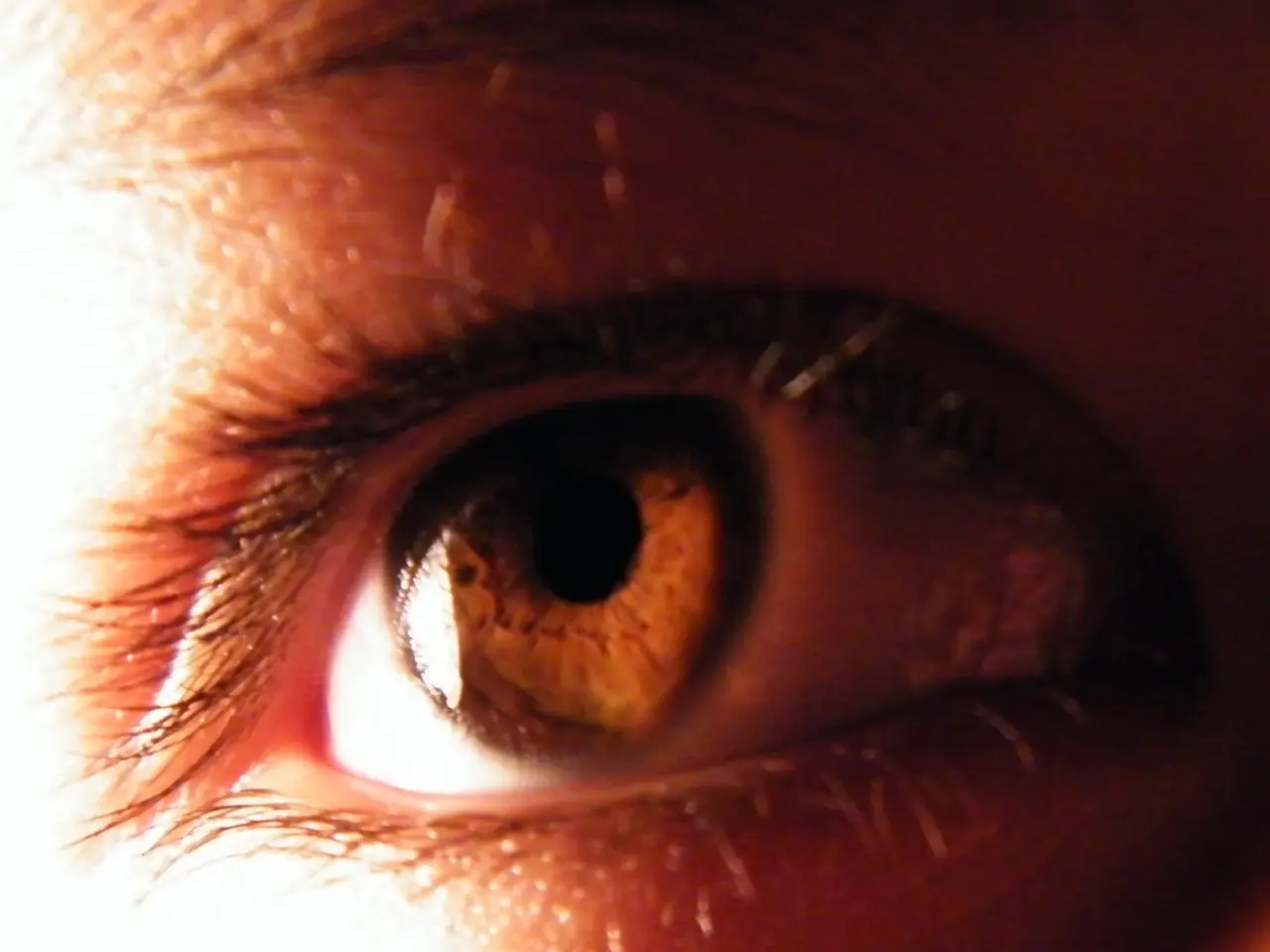Eye inflammation on the eyelid: Signs, remedies, origins, and further details
Eyelid dermatitis, a condition that causes the skin around the eyes to become dry, itchy, and irritated, is a common issue that affects many individuals. This condition can be triggered by a variety of irritants and allergens that come into contact with the delicate skin of the eyelids.
One of the most common triggers for eyelid dermatitis is repeated contact with water and cleansing products such as soaps, cleansing milk, make-up removers, micellar water, shampoos, and detergents. The mixture of moisture with traces of these substances can lead to inflammation primarily in the eyelid crease and then spreading across the eyelid [1].
Cosmetics and eye makeup products like creams, serums, eye shadows, mascara, pencils, and eyeliner are also frequent triggers. The repeated application of these products can adversely affect eyelid health [1][2].
Allergens such as pollen, pet dander, dust mites, and certain skincare products can provoke allergic reactions resulting in eyelid dermatitis. Harsh chemicals and fragrances found in soaps, shampoos, facial cleansers, perfumes, and fragrances are common irritants that can inflame eyelid skin. Other contact allergens including nickel, latex, and certain eye drops or materials like tissues, makeup sponges, and brushes may also trigger dermatitis [2][4].
Environmental factors and stress such as seasonal changes and psycho-physical stress can contribute to the condition. People with a history of atopic dermatitis (eczema) have a higher predisposition to develop eyelid dermatitis, given the skin barrier and immune system sensitivities associated with this condition [4].
Infections from viruses or bacteria may also cause rashes around the eyes, but these differ from dermatitis which is primarily caused by irritation or allergic reactions [2].
Symptoms of eyelid dermatitis due to an irritant typically develop within a few hours or days of contact with a trigger substance. They include irritation, swelling, redness, and discoloration of the eyelids. If left untreated, eyelid dermatitis can lead to lichenification, a process where the eyelids become thickened.
Home treatments for eyelid dermatitis can include moisturizing, avoiding harsh soaps, and wearing protective eyewear when spending time around triggers. However, in some cases, medical treatments may be necessary to help manage symptoms. Some complications that may occur with eyelid dermatitis include skin infections, eye infections, difficulty sleeping, other skin conditions, neurodermatitis, and chronic scratching or rubbing can cause the skin to become discolored and thickened.
Vaseline may improve eyelid dermatitis symptoms by repairing the skin barrier and retaining moisture, but care should be taken to ensure it does not get in the eye. Atopic dermatitis can develop on the eyelids and cause other eye issues.
A doctor may be able to diagnose the form of dermatitis via a physical exam and asking questions about symptoms. If the doctor suspects an allergy, they may recommend a patch test. Eyelid dermatitis due to contact with an allergen or irritant may resolve on its own once a person avoids the trigger.
Allergic contact dermatitis is a type of eyelid dermatitis that develops due to an allergic reaction to a substance such as pollen or certain cosmetic products or metals. Corticosteroid creams can be used to treat inflammation and reduce dryness in eyelid dermatitis, but they can lose effectiveness if used for too long and may cause side effects such as acne, hair growth, and thinning of the skin.
Identifying and avoiding triggers such as certain makeup brands, sunscreen, perfumes, swimming goggles, eye drops, false eyelashes, contact lens solution, airborne allergens, and moisturizers can help prevent flare-ups. Certain factors that may increase the likelihood of eyelid dermatitis include age (infants are more susceptible), genetics, certain professions, certain medications, medical conditions, and hay fever or asthma.
Preventive measures that may help eyelid dermatitis include avoiding scratching or rubbing eyelids, making dietary changes, trying anti-itch products, wearing protective gear, moisturizing regularly, avoiding harsh soaps, restricting makeup use, and avoiding fragranced products. Seborrheic dermatitis is a common condition that causes the skin to become inflamed and flakey, and can affect oily areas of skin, such as the eyelids.
Calcineurin inhibitors are medications that treat inflammatory disorders, including atopic dermatitis, and are available as a cream or ointment for delicate areas of skin. It is best to keep the eye area clean and avoid touching or scratching it to manage eyelid dermatitis.
If you have concerns about eyelid dermatitis, it is best to contact a doctor as soon as possible. They can help determine the cause and advise on treatments to help manage symptoms and reduce flares. Moisturizing creams can relieve dryness and itching in eyelid dermatitis, but it is best to consult a doctor or pharmacist before using.
- Eyelid dermatitis, a disease affecting the skin around the eyes, can be triggered by repeated contact with water and cleansing products like soaps, shampoos, or make-up removers.
- Allergens such as pollen, pet dander, dust mites, or certain skincare products can lead to allergic reactions resulting in eyelid dermatitis.
- Cosmetics and eye makeup products, including creams, serums, eye shadows, mascara, pencils, and eyeliner, are frequent triggers for eyelid dermatitis.
- Environmental factors and stress, such as seasonal changes and psycho-physical stress, can contribute to the development of eyelid dermatitis.
- People with a history of atopic dermatitis (eczema) have a higher predisposition to develop eyelid dermatitis due to the skin barrier and immune system sensitivities associated with this condition.
- Infections from viruses or bacteria may cause rashes around the eyes, but these differ from dermatitis which is primarily caused by irritation or allergic reactions.
- Symptoms of eyelid dermatitis include irritation, swelling, redness, and discoloration of the eyelids, which can lead to lichenification if left untreated.
- Home treatments for eyelid dermatitis include moisturizing, avoiding harsh soaps, and wearing protective eyewear when spending time around triggers.
- Allergic contact dermatitis is a type of eyelid dermatitis that develops due to an allergic reaction to a substance, such as pollen or certain cosmetic products or metals.
- Preventive measures to help manage eyelid dermatitis include avoiding scratching or rubbing eyelids, making dietary changes, and moisturizing regularly.
- Seborrheic dermatitis, a condition that causes the skin to become inflamed and flakey, can affect oily areas of skin, such as the eyelids.
- Calcineurin inhibitors, medications that treat inflammatory disorders, are available as a cream or ointment for delicate areas of skin and can help manage symptoms of eyelid dermatitis.




